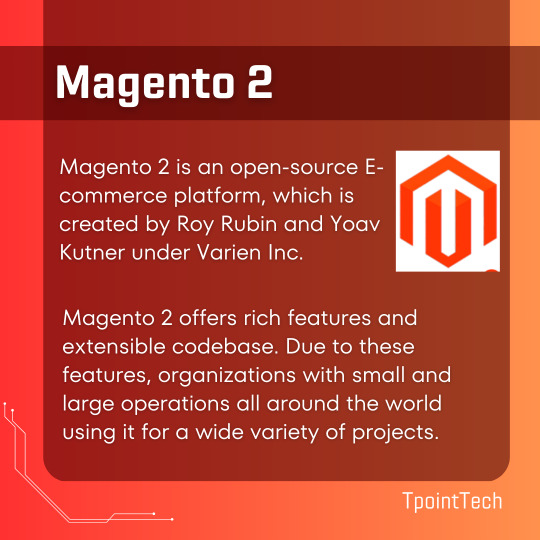#MAGENTO2
Explore tagged Tumblr posts
Text
#ecommerce#dataentry#management#onlinebusiness#multichannel#magento2#shopify#amazon#woocommerce#bigcommerce
2 notes
·
View notes
Text

Which file is required in every Magento 2 Module?
A) module.xml B) config.xml C) index.php D) style.css
#quiz#MCQ#magento2#module#modulequiz#magento2quiz#magento2modulequiz#followme#followforfollow#instadaily#follow4follow#like4like#wednesdaywisdom#letsconnect#scriptzol
3 notes
·
View notes
Text

If you're searching for a dependable partner for Magento development, our team of skilled Magento developers can assist you in building a secure and scalable e-commerce store that caters to your specific requirements.
Get in touch with us today to discover more about our Magento development services! 👉 www.amigoways.com/magento-development
#Magento#Ecommerce#MagentoDevelopment#WebsiteDesign#WebDesign#OnlineStore#OnlineBusiness#Magento2DevelopmentCompnay#Magento2DevelopmentServices#Magento2Development#Magento2pluginDevelopment#Magento2#MagentoPluginDevelopment#BusinessPartner#BusinessGrowth#ReliableServices#EcommerceSolutions#DigitalTransformation#TechExpertise#letsconnect#amigoways
3 notes
·
View notes
Link
0 notes
Text
Professional Freelance Magento Developer for Custom Solutions

Need a reliable freelance Magento developer ? I offer expert services in building and optimizing Magento eCommerce websites, from custom themes and extensions to performance tuning. With a focus on responsive design, SEO, and security, I help you create a seamless shopping experience that drives conversions and business growth. Let’s build your perfect Magento store!
#magento website development#magento development#ecommerce#magento services#web development#magento developers#magento web developer#magento2
0 notes
Text
Magento 2 Product QR Code Generator Extension - Simplify Your Store
Simplify your store operations with the Magento 2 Product QR Code Generator Extension. This powerful tool enables you to create unique QR codes for your products effortlessly. Enhance customer experience by providing quick access to product details, promotions, and more. With easy integration and customization options, this extension helps streamline product management while boosting engagement.
Ideal for modern eCommerce stores, it ensures seamless QR code generation and scanning. Save time, improve efficiency, and deliver a superior shopping experience with this must-have Magento 2 extension. Explore its features today and take your store to the next level!
#magento2#magento2extension#ecommercestoresextension#ecommercestores#magento2tools#dotsquares#dotsquaresstores
0 notes
Text

Boost Your Business with Adobe Commerce (Magento) Solutions
Elevate your e-commerce business with Dotsquares, a Bronze Adobe Solution Partner and Magento Business Partner. Our certified developers specialize in Adobe Commerce (Magento), the world's leading commerce platform, offering virtually unlimited customizations with enterprise-class performance.
We provide comprehensive services, including platform assessments, Magento 1 to Magento 2 upgrades, data migration, performance enhancements, and multi-vendor marketplace solutions.
Visit our website or contact us today to learn how Adobe Commerce can transform your e-commerce strategy. Let’s take your business to the next level!
#adobecommerce #magento #magento2 #magento2solution
1 note
·
View note
Text

Magento 2 . . . . for more information and tutorial https://bit.ly/3OAqOpj check the above link
0 notes
Text
ChatGPT Made a Magento 2 Module YOU GOTTA SEE ?
ChatGPT Creates Magento 2 Module: The Future of Software Development?
In a recent YouTube video, Mark Shust, a Magento 2 developer, shared how he used ChatGPT to create a complete Magento 2 module. The module is called "Mark Shust Layout Handle Logger" and it logs all layout handle processing that occurs on the website.
Shust used ChatGPT to generate the PHP code for the module. He provided ChatGPT with some input information, such as the module name, description, and required functions. ChatGPT then generated PHP code for all of the necessary components of the module, including the module class, service class, template class, and additional classes.
The module created by ChatGPT works flawlessly. It accurately logs all layout handle processing that occurs on the website. Shust tested the module on a number of Magento 2 websites and he was very impressed with the results.
Shust's video has generated a lot of attention from the Magento 2 community. Many people have expressed surprise and awe at ChatGPT's ability to generate PHP code. Some people even believe that ChatGPT could change the future of software development.
Can ChatGPT Change the Future of Software Development?
The answer is yes, ChatGPT has the potential to change the future of software development. ChatGPT is a large language model, trained on a massive dataset of text and code. This allows ChatGPT to generate high-quality PHP code.
ChatGPT can be used to create modules, extensions, and even complete Magento 2 applications. This can help developers save time and effort.
However, ChatGPT is still under development. It does not always generate perfect code. Developers still need to test and edit the code generated by ChatGPT.
Regardless, ChatGPT is a tool with great potential. It can help Magento 2 developers create new and innovative software solutions more quickly and easily.
My Thoughts on ChatGPT
I think ChatGPT is a very impressive tool. It has the ability to generate high-quality PHP code. I believe that ChatGPT can be used to improve the efficiency of the software development process.
However, I also recognize that ChatGPT is still under development. It does not always generate perfect code. Developers still need to test and edit the code generated by ChatGPT.
Regardless, I believe that ChatGPT is a tool with great potential. It can help Magento 2 developers create new and innovative software solutions more quickly and easily.
Conclusion
ChatGPT is a powerful tool that has the potential to revolutionize the way software is developed. It is still under development, but it has already shown that it can be used to create high-quality PHP code. As ChatGPT continues to develop, it is likely to become even more powerful and versatile.
youtube
#Mageplaza#Ecommerce#ChatGPT#Magento2#CustomerService#EcommerceInnovation#ArtificialIntelligence#CustomerExperience#OnlineShopping#EcommerceTechnology#MagentoModule#VirtualAssistant#Personalization#CustomerSupport#EcommerceSolutions#TechInnovation#AIinEcommerce#MagentoExtension#CustomerEngagement#EcommerceTrends#MagentoStore#Youtube
12 notes
·
View notes
Text
The Magento 2 WebP Image Converter extension addresses the challenge of serving images in next-gen formats, as highlighted by Google's PageSpeed Insights tool for JPEG or PNG images. Converting images to WebP format, enhances loading speed, user experience, and SEO performance.
Convert JPEG, PNG or GIF images to WebP images or AVIF images.
Boost web performance with better loading.
Automated image conversion.
Enhance customer experience and SEO rankings.
Remove WebP images when extension is disable.
Compatibility with all web browsers.
Scan and optimize WebP/AVIF images via cron job or manually.
Show responsive images for CMS pages.
0 notes
Text

scriptzol Provides Extensions In #Magento2 #Wordpress #Prestashop #OpenCart #CSCart
Buy The Suitable Module From Us For Your Business! 👉 www.scriptzol.com
#scriptzol#extension#module#plugin#magento2#wordpress#prestashop#opencart#cscart#modules#magentomodules#WooCommerce#EcommerceSolutions#WebDevelopment#OnlineBusiness#DigitalCommerce#WebsiteSolutions#OnlineStore#BusinessGrowth#TechSolutions#CustomModules#letconnects#letsconnect#scriptzolmodule#scriptzolextension#scriptzolplugin#scriptzoladdons
5 notes
·
View notes
Text

🚀 Migrating to Magento 2? Avoid common pitfalls with these quick fixes! 👇
0 notes
Text
youtube
Hire Magento Development Services | Connect Infosoft Technologies
Our experienced team provides end-to-end Magento development, including custom module development, theme customization, performance optimization, and seamless third-party integrations.
#magentodevelopment#Ecommerce#ConnectInfosoft#Magento2#WebDevelopment#OnlineStore#DigitalSolutions#CustomDevelopment#WebDesign#MagentoExtensions#WebDevelopmentCompany#PHPDevelopmentCompany#Facebook#Pintrest#Software#Trending#ViralVideo#Reel#Youtube#Instagram#usa#nigeria#lagos#florida#purtgal#europe#bulgaria
1 note
·
View note
Text
1 note
·
View note